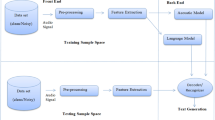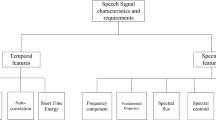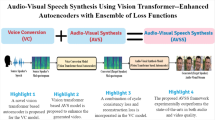Abstract
This paper proposes an algorithm that adopts the harmonic regeneration as post-processing to improve the performance of speech enhancement using traditional Short Time Spectral Amplitude (STSA). The proposed algorithm aims to alleviate the distortion of the high harmonics of enhanced speech via the traditional STSA, and consequently improves the speech quality. We first detect the pitch, or fundamental frequency, of the enhanced speech via the traditional STSA, and then, divide the whole spectrum into multiple sub-bands which center on each harmonic. After that, a series of specially designed windows centered on each harmonic are applied to all the sub-bands, in order to redistribute the energy in the sub-bands. The results of experiment demonstrate that the method has both theoretical and practical basis.
Similar content being viewed by others
References
Y. Ephraim and D. Malah. Speech enhancement using a minimum-mean square error short-time spectral amplitude estimator. IEEE Transactions on Acoustics, Speech and signal Processing, 32(1984)6, 1109–1121.
E. Plourde and B. Champagne. Further analysis of the -order β MMSE STSA estimator for speech enhancement. Canadian Conference on Electrical and Computer Engineering, 2007, Ottawa, Canada, Jul. 2007, 1594–1597.
L. Akter and M. d. Kamrul Hasan. Crosscorrelation compensated wiener filter for speech enhancement. 2006 IEEE International Conference on Acoustics, Speech and Signal Processing, Toulouse, France, May 14–19, 2006, 1–1.
C. Plapous, C. Marro, and P. Scalart. Speech enhancement using harmonic regeneration. IEEE Internation Conference on, Acoustics, Speech, and Signal Porcessing, Philadelphia, USA, May 2005, Vol. 1, 157–160.
T. Yoshioka, T. Nakatani, and H. G. Okuno. Noisy speech enhancement based on prior knowledge about spectral envelope and harmonic structure. IEEE International Conference on Acoustics Speech and Signal Processing (ICASSP), Dallas, Texas, USA, March 2010, 4270–4273.
Y. Stark and J. Tabrikian. MMSE-based speech enhancement using the harmonic model. IEEE 25th Convention of Electrical and Electronics Engineers in Israel 2008, Dec. 2008, 626–630.
Jin Wen, Lin Xin, and M.S. Scordilis, et al. Speech enhancement using harmonic emphasis and adaptive comb filtering. IEEE Transactions on Audio, Speech, and Language Processing, 18(2010)2, 356–368.
Xuchu Hou, Shengnan Guo, and Ye Li, et al. Speech enhancement for non-stationary noise environments. International Conference on Information Engineering and Computer Science, Wuhan, China, Dec. 2009, 1–3.
D. Arifianto and T. Kobayashi. IFAS-based voiced/unvoiced classification of speech signal. IEEE International Conference on Acoustics, Speech and Signal Processing, 2003, HongKong, China, Vol. 1, I-812–I-815.
Daniel W. Griffin and Jae S. Lim. Multiband excitation vocoder. IEEE Transactions on Acoustics, Speech and Signal Processing, 36(1988)8, 1223–1235.
Rainer Martin, David Malah, and Richard V. Cox, et al. A noise reduction preprocessor for mobile voice communication. EURASIP Journal on Applied Signal Processing, 2004(2004)8, 1046–1058.
C. F. Chan and E. W. M. Yu. Improving pitch estimation for efficient multiband excitation coding of speech. Electronic Letters, 32(1996)10, 870–872.
An-Tze Yu and Hsiao-chuan Wang. New speech harmonic structure measure and it application to post speech enhancement. IEEE International Conference on Acoustics, Speech, and Signal Processing, 2004, Vol. 1, I-729–32.
Author information
Authors and Affiliations
Corresponding author
Additional information
Supported by the National Natural Science Foundation of China (No. 60572081).
Communication author: Zhang Yanfang, born in 1987, female, Master.
About this article
Cite this article
Zhang, Y., Tang, K. & Cui, H. Speech enhancement using harmonics regeneration based on multiband excitation. J. Electron.(China) 28, 565–570 (2011). https://doi.org/10.1007/s11767-012-0724-z
Received:
Revised:
Published:
Issue Date:
DOI: https://doi.org/10.1007/s11767-012-0724-z
Key words
- Speech enhancement
- Short time spectral amplitude
- Harmonic regeneration
- Multiband excitation
- Pitch detection




